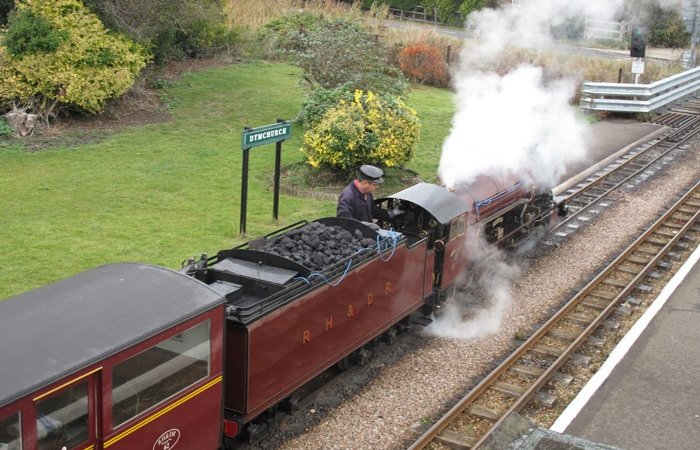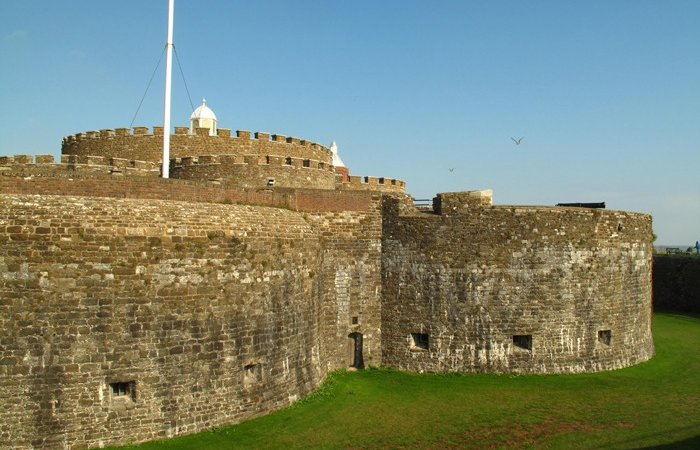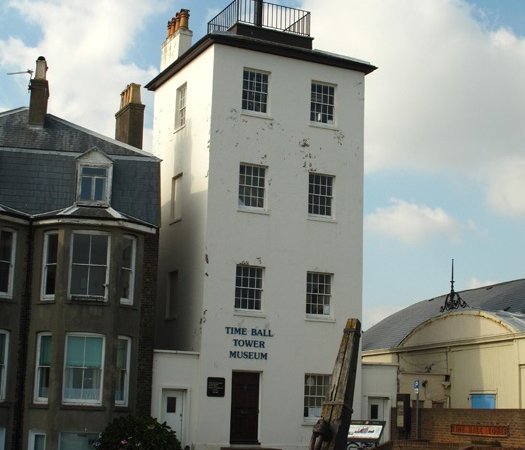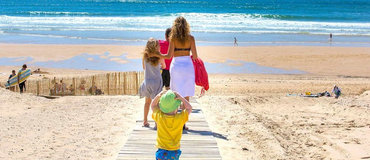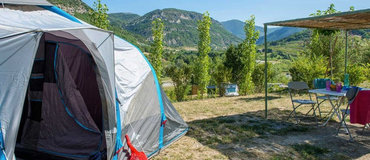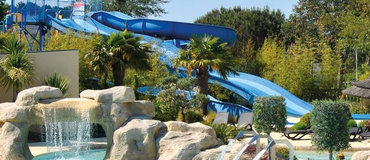
Guarding the vulnerable Kent coastline from invasion has been going on for centuries – let's find out more.
"Doctor Syn," rasped the voice from the radio, as it recounted the lurid tales of a daring smuggling ring on Romney Marsh led by the character’s alter ego, the ‘Scarecrow’. Images of Romney Marsh as a dank, dark and scary place filled my head, while I listened to the gripping story – Doctor Syn: A Tale of the Romney Marsh, by Russell Thorndike. But when I drove across it the sight of a distant tiny steam train chugging its way across the landscape painted a more pastoral picture.
I raced the train to the station at Dymchurch, the parish of the fictitious Doctor Syn and his band of smugglers, and was in time to see it pull in at the platform. The driver looked huge as he crouched in the seat behind the miniature engine, and the guard towered over the carriages as he waited for its passengers to disembark so he could wave the train on its way. The Romney, Hythe and Dymchurch railway is the world’s smallest public railway and its one-third size engine and carriages run for 13.5 miles between Hythe and Dungeness and its National Nature Reserve along 15in gauge track. It's a great destination if you're having a caravan, camping or motorhome holiday in Kent – a super day out for all the family.
Seeing the tiny train was a treat but it wasn’t the reason for my visit to the Kent coast. I was here to explore some of the old towns in the ancient Cinque Ports confederation. If you're looking for a reason to head to the Garden of England, something around which to plan a camping, caravanning or motorhome holiday, I think it's a pretty good one. Along the Kent coast there are castles to explore and ancient towns to visit – and at Capel le Ferne I had found a campsite that was just about at the heart of my chosen area.
My home for the next five days was a Sterling Eccles Sport 544 caravan and I had lured my non-caravanning friend Mary-Anne along with the promise of visiting glorious gardens, fascinating forts and a delightful tearoom or two. My chosen campsite, Little Satmar, was in its final week of the season and I had the pick of the pitches, which meant I could just drive onto the grass and stop near a hook-up without having to reverse – ideal. Setting up was painless. Then all we had to do was find provisions – and for that we headed into Folkestone and a large supermarket.
A great Deal
Deal is a limb of the Cinque Port of Sandwich and has two castles – Deal and Walmer – to protect it from seaborne aggressors. The castles are located on the seafront, just two miles apart. They were built under the orders of Henry VIII as part of his fortifications of the south coast and both are laid out in the shape of a Tudor Rose. Defence-wise, the rose shape makes sense. The castles are low to make them difficult targets for the cannon of attacking ships, plus their walls are curved so that when ammunition did find its mark it was deflected. Both castles are remarkably intact.
Walmer Castle is the official residence of the Lord Warden of the Cinque Ports. Up until her death in 2002, Queen Elizabeth, the Queen Mother, held this honorary post. The present incumbent is Admiral Lord Boyce. We began with Deal Castle, which has an adjacent car park. Once through the huge, metal-studded wooden door we discovered the fort is pretty much devoid of furnishings. Stone and mortar alone tend not to hold your interest for long so we opted for the free audio tour, which brought to life the story of the castle as a defence garrison as it guided us through the officers’ rooms and kitchens, and down spiral staircases into the tunnels below.
Deal still has a fishing industry and its beach was busy with boats being maintained when we visited. We walked past the Time Ball Tower – a fascinating piece of engineering that can be seen by ships at sea. The position of the ball helps them monitor the accuracy of their chronometers, which they need for calculating their accurate position at sea – a sign explains it all. We had taken our photo at three minutes to the hour when the ball is at the top of the mast. It receives a signal to drop exactly at the hour from the atomic clock in Cumbria. Genius – who thinks of these things?
We were hungry and settled on Dunkerleys on the seafront for lunch. Fully fuelled we then wandered further along the beach, past the last pier to be built in Britain – a concrete 50s job that apparently is the same length as the Titanic – and on as far as the Royal Hotel, also a great spot for lunch. Deal is a lovely little town but it hasn’t always been so genteel; its warren of narrow streets and closeness to France made it notorious for smuggling activity. A sign in Middle Street revealed some of the town’s more dubious history, describing it as “An impious and remorseless town. Fraud, oppression, theft and rapine reign.” Streuth! We wandered back to the beach and the car, then drove the short distance to Walmer Castle.
Walmer Castle: the Lord Warden’s residence
Furnishings do so much to bring a place to life. Although it must have been tricky placing furniture within all those curved walls, Walmer Castle looked very much the home. You can see the Queen Mum’s bedroom and the room in which the Duke of Wellington died: he was a Lord Warden for 23 years. There’s a pair of his boots there and they aren’t wellies as we know them. Just as at Deal Castle, cannon are still aimed seaward, but Walmer's exterior is softened by beautiful gardens laid out in the moat. There’s a restaurant and a shop within the castle walls and an adjacent car park, as well as one across the road on the beach.
The history of the sandwich
Cheese and pickle Portsmouth anyone? Did you know that your lunchtime sarnie might very nearly have been called a Portsmouth? The first Earl, Edward Montagu, was considering the title Earl of Portsmouth before he settled on Sandwich. It was the fourth Earl of Sandwich who called for a piece of meat between two slices of bread to keep his fingers grease free and thus invented the ultimate convenience food.
The ancient town of Sandwich was one of Kent’s most important ports before the River Stour clogged with silt – and was one of the original Cinque Ports. It, too, has a fort, but it was built long before the confederation was thought of.
Richborough, two miles north of Sandwich, is close to where the Romans first landed on our fair isle and here they built a mighty fort. It is about 20 miles from Little Satmar, so fuelled with a rather fine caravan brekky of poached eggs on toast, we headed east across the beautiful Kent countryside.
The site of the fort is enormous and studded with vast stone walls and deep gullies, where an amphitheatre once stood. The fort played an important role during the entire Roman occupation of Britain and there are signs around the site telling the story and explaining the function of the different areas. You can get an audio guide here, too: great if it’s a sunny day and you have all the time in the world. The place was awesome, but it was windy when we visited and after an hour or so we’d had enough.
The weather had brightened considerably by the time we got to Sandwich. We parked behind the Guildhall, which contains a small museum that tells, among other things, of the town’s importance in developing medicines. The Guildhall was also the court and has an interesting list of punishments that were handed out during the 15th and 16th centuries. Sandwich must have been a marvellous place to live even then because banishment was often used as a deterrent. In 1471, a thief was banished for life, and if he dared return his ear would be nailed to a cartwheel with a fourpenny nail! Nasty.
The town is said to be one of the best-preserved medieval towns in Britain and it certainly has its fair share of timber-framed buildings and ancient walls. We explored narrow alleys, found the town jail, then popped into the ancient church of St Mary’s that was eerily empty of pews. The church was interesting just for its incredible wooden strutted ceiling. Hunger hit as we wandered towards the Sandwich toll bridge and with a little more strolling along Fisher Street we came across the George and Dragon, which claims to have been serving ale and food since 1446. Stopping for lunch was also a good excuse to rest our feet.
Just around the corner from the pub is the intriguingly named Secret Gardens of Sandwich, which was a must for two keen gardeners. The gardens surround a beautiful Edwin Lutyens building called The Salutation, which has guest accommodation starting at £160 per night. A bit rich for us and anyway, we had our caravan, but at least we were able to enjoy the beautiful grounds for a modest fee. The gardens were designed by Lutyens and Gertrude Jekyll. If we hadn’t just had lunch we would have stopped for a cuppa and cake in the tearoom.
Cinque Ports three and four
New Romney and Hythe were on the next day’s agenda. We left our campsite and headed west from Folkestone along the A259 coast road, passing through Sandgate and into Hythe. Silting from the great storms of the late 13th century meant Hythe had lost its status as an important port long ago, but it and Romney Marsh were still vulnerable to attack. When Napoleon Bonaparte started casting his acquisitive eye in the direction of England, plans were put in place to build a grand canal to impede his advance. The Royal Military Canal was built but the attack never came – the canal is now a pleasant waterway to wander and picnic by.
Hythe is a lovely little town with a long high street to peruse. We stopped by Aunty Wainwright’s antiques to see if there was a bargain to be had, but found ourselves drawn by the lurid pink of the café next door, so we stopped for a coffee and muffin to prime ourselves for the climb up to St Leonard’s Church.
The 1000-year-old building stands high over a network of narrow streets and is very handsome, but probably the most interesting thing about it is its ossuary. We were spared the grisly sight of hundreds of human skulls by arriving three minutes after it had closed for the season. We cleansed the bones from our thoughts by popping into Posh Potions (for body and home), before returning to the car and rejoining the coast road.
Shrubbery and then the seawall obscure much of the seaward view along the road as you come into Dymchurch, and on the land side there are plenty of static caravan parks. And the reason is that on the other side of that wall is a vast sandy beach. We passed through the flat landscape of Littlestone-on-Sea and New Romney, as we wanted a quick look at Dungeness and the garden of Derek Jarman.
It’s a miracle there is a garden at all in this very bleak place littered with shipping crates, but I rather liked it. We returned to New Romney, which also suffered badly during the great silting, so much so that the town is now a mile from the sea and the River Rother changed its course to exit at Rye further along the coast. The streets between the buildings became so silted that steps had to be created to get down to the doors, and some windows are very low, almost at street level. The town is no longer a port but retains its Cinque Ports title.
Dover at the vanguard of defence
We had notched up four ports and three forts, but we had still to visit the big daddy of them all – Dover Castle. The vast, grey, granite castle has stood high above the very busy port since the 12th century, protecting the shortest crossing between Britain and France. It’s so large and in some places very steep that there’s no disgrace in taking the land train that winds its way around the grounds to the various highlights.
Inside the great tower, holograms of servants going about their business bring the castle to life. Mary-Anne and I disagreed over this, she thought it Disneyesque and cheap, and I thought that kids would get a lot more out of this ‘visual history’.
The castle was used as a garrison during World War II and has opened up its secret wartime tunnels and underground hospital. Queues for both exhibits were long, but I waited in the shorter line for the hospital and I was glad I did. The wards and operating theatre were poorly lit and you could only wonder at how the medical teams worked under such conditions. It was very atmospheric.
The oldest part of the castle is the Roman lighthouse and right up against that is an Anglo-Saxon church. There’s so much to see there’s almost too much to take in on one visit. I'll definitely return.
On the way back to Little Satmar we stopped by the National Memorial to the Few at Capel-le-Ferne. A black granite wall bears the names of all those who took part in the Battle of Britain. Walk around the grassy mound and you see a statue of an airman sitting, staring out to sea as though waiting for the aircraft to return. It is incredibly moving and seemed a fitting end to a visit that had been all about the protection of our shores.
Where to stay
Folkestone Camping and Caravanning Club Site
Broadhembury Caravan and Camping Park
Black Horse Farm Caravan Club Site
Norwood Farm Caravan and Camping Park
